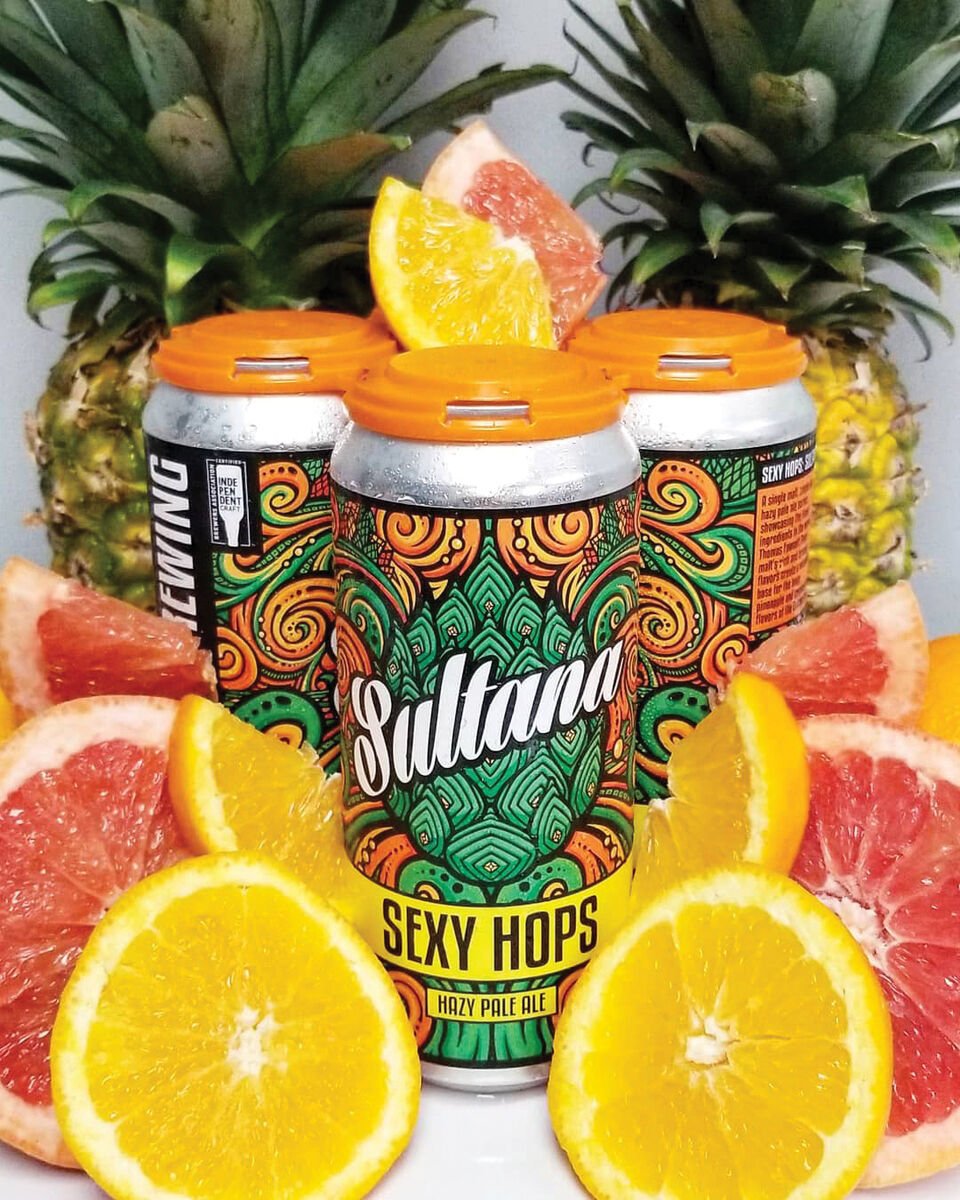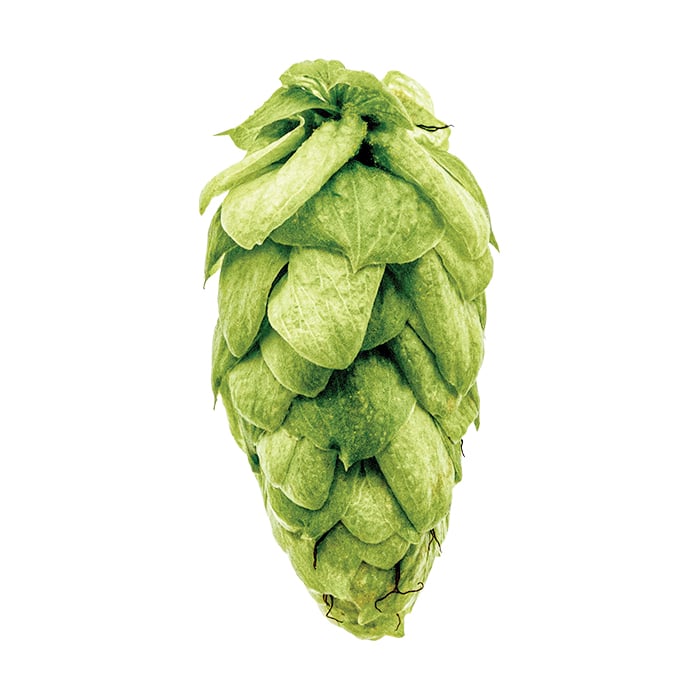Start 14-Day Trial Subscription
*No credit card required

Trending Hops for 2022
The Hop Report - Without hops, beer would be far less interesting. Check out some of the trendiest hops to keep an eye on in 2022.
Imagine an Old Fashioned cocktail with no aromatic bitters. Think of a bowl of gumbo with no seasonings. Or jerk chicken without the jerk. In a similar vein, what would beer be without hops?
Hop flower cones impart balancing aromatics, flavor and bitterness when boiled in wort or added as dry hops in young beer. European brewers in the Middle Ages lucked out when they experimented with adding fragrant wild hops to their brews. Not only did hops extend the life of the beer and help prevent bacterial spoilage, but early brewers also quickly discovered that hops cut the beer’s sweetness with a pleasant bitterness that made ales more palatable, enjoyable and dry.
The bittering potential of hops increases as the percentage of the flower’s alpha acids increases. Alpha acids are molecules located in the yellow resin glands of hop flower cones. When added at the end of the wort boiling process, alpha acids and other hop oils provide aroma and a touch of flavor. When added slightly earlier, hops produce deeper flavors in the beer. A longer boil time with hops causes increased isomerization of alpha acids that contributes to pleasant bitterness. A hop variety with 4% alpha acids offers a slight bittering potential, while hops with 10+ alpha acid percentages pack considerable bittering capabilities.
Medieval brewers would probably become confounded by the myriad modern hop varieties that have been cultured and cross-bred to impart an extraordinary range of aroma and flavor notes. This article showcases a sensational collection of 13 established and experimental hop varietals that show promise for 2022 and beyond.
Harlequin
As hop suppliers in England for over 150 years, hop merchant Charles Faram stocks an impressive array of hop varieties in whole leaf and pelletized form – all stored in cooled warehouse spaces. The company has also opened a rapidly expanding branch in the USA. In the 1980s, Charles Faram transitioned to a grower-owned operation, and Charles Faram Farms was created in 2021.
The guys at Charles Faram & Company in the U.K. hold high expectations for their new Harlequin hop varietal. Created as part of the Charles Faram Hop Development Program, Harlequin works well as a late addition hop for aroma and flavor and also excels when added at the beginning of the boiling process for bitterness. Arising from a lineage that includes Godiva and Jester hops, Harlequin was first planted in 2015 and was voted a favorite at 2016’s AromaFest hop competition that compared Charles Faram hops from the U.K., U.S., Poland, Czech Republic and Slovenia.
“Harlequin has a good alpha acid range of 9-12% and a high oil and resin content with aromas and flavors described as passion fruit, peach and pineapple,” notes Charles Faram’s Dylan Taylor. “The variety also maintains the trademark earthy, herbal character associated with U.K. hops.”
Paul Corbett, Charles Faram’s managing director, picks up lovely pomegranate and pineapple characters in beers brewed with Harlequin. He adds: “This, coupled with the hop’s excellent agronomic qualities, means that we can supply our customers with a hop that produces ‘New World’ aroma from a U.K.-grown variety. For British brewers, this means much lower food miles and a lower carbon footprint. It’s an exciting time for British hops, and we hope to be pushing forward with even more aromatic varieties in the near future.”
Nectaron
Corbett also shares his excitement about a new hop variety from New Zealand. Nectaron offers brewers a characteristic pineapple, tropical fruit, stone fruit and citrus profile that works well in New England and West Coast IPAs along with pale ales and modern hoppy lagers.
Nectaron has garnered many awards and seems well-suited for late or dry hopping. John Harris, a pioneering Oregon brewer who now fills the role of brewmaster at Ecliptic Brewing in Portland, agrees that Nectaron expresses marvelous hop nuances. “Nectaron provides beautiful tropical and citrus character in the same hop,” he says. “I’ve loved brewing with this new variety and just hope we can get more.”

Sultana
Hopsteiner hop merchant group began in 1845 in Germany. The company has earned respect worldwide as a leader in hop growing research, creative breeding programs and innovative ways to process and utilize hops. Hopsteiner now boasts an extensive footprint of farms in the Yakima Valley of Washington and grows more than 70 hop varieties while constantly working to cultivate new strains. Breeding a successful new hop strain requires extensive work over ten years or so. Hopsteiner shows deep enthusiasm for its new Sultana and Lotus hops.
Formerly known as Hopsteiner Experimental #6277, Sultana offers high yields, noteworthy aroma notes and exceptional agronomical attributes. After planting, Sultana grows into a hardy beast of a tall vine producing extralarge hop cones. The variety offers a distinctive canvas of aromas and flavors that include pineapple, subtle pine resin and fresh citrus. Brewers can expect a potent alpha acid range of 13 to 15 percent. “Cracking open a fresh can of pineapple chunks provides a pretty good approximation of Sultana’s aroma profile,” explains Guy Perry of Hopsteiner UK.
Lotus
Hop plants are perennials with extensive root-like rhizomes that hibernate under the soil over the winter months. When spring arrives, hops quickly sprout shoots that climb to levels of around 15 to 20 feet. Hopsteiner’s Darren Stankey notes, “This revitalization sets in motion rapid growth for the rebirth of a new crop that culminates during the annual hop harvest at the end of each summer. In hop farming country, this is a special time when farmers gather to prepare the crops and brewers from across the globe migrate to the area to select the hops they will use in the coming years.”
Revered in Eastern cultures, lotus flowers represent rebirth and replenishment. Hopsteiner’s Lotus hop got its name as an homage to the annual traditions of hop rebirth and harvest. Lotus provides appealing aromas and flavors of orange, vanilla, berries, tropical fruits and sweet grapes. Lotus hops have 13 to 17 percent alpha acids and show good resistance to attack from aphid insects and powdery mildew fungus.
Zappa
The new Zappa hop variety is owned by CLS Farms in Moxee, Washington. Yes, it’s named after Frank Zappa. Look for an alpha acid range of 7 to 9 percent and a hardy lineage of Neomexicanus aroma hops that grow in the mountains of New Mexico. Tom Britz, president of Glacier Hops Ranch in Montana, explains, “This native New Mexico variety thrives in Montana, and when doing our ‘hop rubs,’ it was loaded with intensely aromatic hop notes. The profile is a combination of Fruity Pebbles cereal, tropical fruit, spicy black pepper, citrus, pine, savory notes and ‘purple.’ It just smells purple.”
Ahhhroma
The new Ahhhroma hop is owned by Glacier Hops Ranch. As the name suggests, the aromatics come across as quite noteworthy in this variety that boasts 15 to 19 percent alpha acids. Tom Britz adds, “Ahhhroma came out of our research hopyard a few years ago, and we previously only distilled it into Hopzoil, our pure essential hop oil made from fresh hops. This year was the first time we had enough acreage to put it into pellets, and the lab said it reminded them of a piña colada with fresh pineapple, citrus and floral notes. I see Ahhhroma as a spot-on hop choice for many popular IPAs.”
Bitter Gold
Brian Tennis, founder of Hop Alliance in Michigan, has developed a deep appreciation for Michigan-grown Bitter Gold and New Zealand-grown Motueka. “Bitter Gold is a dual-purpose hop clocking in at 13 percent alpha acid,” he says. “It has big, bold tropical fruit flavors along with stone fruit, watermelon and even candy-like notes with a solid dank backbone. Bitter Gold is a U.S. public hop variety. This is critical for small to mid-size hop growers, as the hop is not proprietary – anyone can grow it.”
Motueka
Grown for Hop Alliance by Pikimai Hops in Tapawera, New Zealand, Motueka offers a distinctive New Zealand taste and aroma. Hop Alliance’s Brian Tennis picks up notes of “fresh tropical lemon and lime with floral and stone fruit aromatics.” With 6 to 8 percent alpha acids, Motueka was initially developed in the hop breeding program of New Zealand’s Institute for Plant & Food Research. Motueka’s beautiful aromatic character works well in IPAs, modern lagers and hoppy Belgian-style beers.
Pacific Sunrise
Idaho’s Mill 95 exists as an independent hop service provider for craft breweries. The land surrounding southwest Idaho’s Route 95 makes for outstanding hop cultivation, and Mill 95 deals in intriguing hops from Idaho, the Pacific Northwest and beyond. Mill 95’s Amaya Aguirre-Landa reveals, “Pacific Sunrise is a New Zealand variety grown by our partner grower Hop Revolution. It’s one of four New Zealand varieties offered by Mill 95. All New Zealand varieties are shipped in refrigerated shipping containers on their way to Idaho to ensure the best quality and freshness.”
Pacific Sunrise ranks as a potent alpha acid hop in the 12.5 to 14.5 percent range. Often considered a dual-purpose hop, Pacific Sunrise provides an exceptionally smooth bitterness while also imparting interesting lemon and tangerine in the nose. Like New Zealand Pacific Jade and Motueka, this hop also produces flavors of flowers, melon, stone fruit, mango, pine and berry.

Triumph
Mill 95 also touts the classic, yet complex, flavor palate provided by Triumph hops – the newest public variety released in 2019 from the USDA breeding program. “It’s a cross between East Kent Golding, Brewers Gold, Nugget and Hallertau Mittelfruh,” explains Mill 95’s Corey Marshall. “Its noble lineage comes through, making Triumph a great lager hop. If people like Juicy Fruit gum, they’ll love Triumph. It offers a great tropical/juicy aroma and a super-smooth bitterness while delivering 11 to 12 percent alpha acids. We see Triumph as a fantastic hop for lagers or IPAs.”
Enigma
As mentioned earlier, craft brewers enjoy traveling to hop-growing areas of the world each harvest season to check out the year’s current and upcoming hop varieties. Brewers travel between different hop fields to rub hop cones between their hands and inhale an aromatized noseful of diverse aromas. The goal is to pick hop varieties that appeal most to the targeted recipes of each brewer. Mitch Steele, co-founder and brewmaster for New Realm Brewing, recently brewed a hazy IPA called HazeLab that utilizes Australian Enigma hops. With 16 to 19 percent alpha acids, Enigma arose from a cross between Tettnanger and an unnamed North American variety. Brewers often comment on the hop’s raspberry, red currant and white wine character. “I love Enigma’s complex fruitiness that offers lots of citrus and tropical fruit notes,” Steele says.
USDA 2006009-074
Experimental hop USDA 2006009-074 is still waiting for an official name, and it may take several years for the hop to prove itself and gain significant acreage. Nevertheless, beer journalist and hop expert Stan Hieronymus expresses anticipation and fascination with this new variety. He explains, “I see three reasons to get excited about this hop. One: she’s a public variety that farmers across the country will be able to access. Two: she’s got the orange, tropical, stone fruit qualities that brewers are seeking. Three: she gets an ‘A’ for agronomics and growing well in places such as New York, Michigan and the Pacific Northwest.”
Cashmere
Terrapin Beer Co. in Athens, Georgia recently brewed a “Cold IPA” fermented with lager yeast and dry-hopped heavily near the end of fermentation for bold hop flavor and biotransformation. Terrapin head brewer Brian “Spike” Buckowski notes, “We used Cashmere hops in our new Cold IPA. Cashmere has a delicate fruitiness with notes of lemon-lime, peach and melon. It also lends a nice, silky-smooth mouthfeel, finish and bitterness.”
Cashmere holds 7 to 10 percent alpha acids and originated from a cross between grapefruit-y Cascade and piney Northern Brewer hops. It’s another dual-purpose hop utilized for pleasant aroma as well as bitterness
Hops and cannabis exist as first cousins. In the rapidly expanding cannabis industry now taking shape in areas where it’s legal, creative new strains and varieties of cannabis bombard consumers with novel colors, aromas, THC levels and flavor profiles. Hops lack the psychoactive effects of cannabis but certainly possess the genetic potential and variability to produce an unprecedented diversity of titillating new aromas and flavors in beer.



